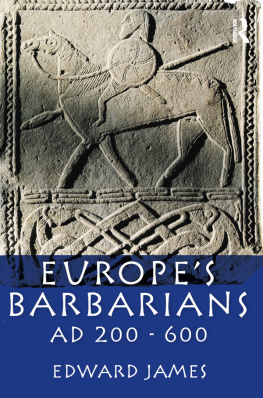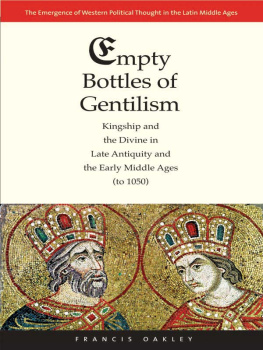Copyright 1973 by the University of Minnesota.
All rights reserved.
Printed in the United States of America
at the University of Minnesota Printing Department, Minneapolis.
Published in the United Kingdom and India by the Oxford University
Press, London and Delhi and in Canada
by the Copp Clark Publishing Co. Limited, Toronto.
Library of Congress Catalog Card Number: 73-77710 ISBN 0-8166-0678-1
For DEBBT
This page intentionally left blank
Preface
In 1922 the Russian scholar M. I. Rostovtzeff wrote, "In most of the work on the period of migrations, the part played by the Sarmatians and especially by the Alans in the conquest of Europe is almost ignored. But we must never forget that the Alans long resided in Gaul,... that they invaded Italy, and that they came with the Vandals to Spain and conquered Africa...." In 1963 George Vernadsky echoed Rostovtzeff's remarks and concluded that during the intervening four decades still no major historical investigation of the Alans in the West had appeared. 1 The present study is aimed at filling this lacuna in the history of early medieval Europe which has already existed too long. 2
1. M. I. Rostovtzeff, Iranians and Greeks in South Russia (Oxford, 1922), p. 237. George Vernadsky, "Eurasian Nomads and Their Impact on Medieval Europe," Stud* Medievali, 3rd ser., IV (1963), 421. Vernadsky has made numerous contributions to the study of the Alans, which are synthesized in the article mentioned above. For Vernadsky's complete bibliography on the Alans and related subjects through 1963, see Essays in Russian History: A Collection Dedicated to George Vernadsky, ed. Alan D. Ferguson and Alfred Levin (Hamden, Conn., 1964), pp. xiii-xxv.
2. The most recent surveys of the Alans are R. Wenskus, "Alanen," Reallexikon der germanischen Atiertumskunde, 1.2 (Berlin, 1970), 122-124; J. Ozols, "Alanen," ibid., pp. 124-126. Ozols discusses the archaeological materials and this discussion is supplemented by T. Sulimirski, The Sarmatians (New York, 1970). Wenskus's attempt to cover Alan history in less than three pages falls short of W. Tomaschek, "Alanen," RE, I, cols. 1282-1285. Sulimirski's treatment of the Alans in the West is less than four pages long (pp. 185-188). See my review of this work in AHR, LXXVI (1971), 1525-1526. In none of these works noted above are the latest studies of the
A History of the Alans
A history of the Alans in the West during the Volkerwander-ung and the early Middle Ages, like histories of the other peoples during those hectic times, helps us to obtain a better understanding of the end of the ancient world and the beginning of the Middle Ages. Unlike the various German tribes which dominated the migrations numerically and have dominated the historical literature of the migrations ever since, the Alans were Indo-Iranian nomads. In fact, the Alans were the only non-Germanic people of the migration period to make important set-dements in Western Europe. The Huns were driven out of Europe; the Avars, Magyars, Bulgars, and Slavs confined their settlements to Eastern Europe. As a unique phenomenon in the history of Western Europe, the Alans have long deserved to be studied.
The history of this nomadic people begins in the West not when they first entered the Roman empire but when Westerners first became aware of the Alans and left some written record of their observations. Therefore, to provide for a better understanding of the Alans' migration westward and their reception, the first chapter of this monograph is devoted primarily to what Westerners thought and said about the Alans before the Volker-wanderung. Secondly, an attempt has been made to ascertain the nature of Alan culture in the period before migration. This latter task is far more difficult than the former because frequently we cannot accept the information provided in the written sources at its face value. In addition, the archaeological evidence is often ambiguous, and we cannot, for example, determine precisely whether a burial or an artifact is Alan, Sarmatian, or Roxolan. 3
Alans in the West consulted. An incomplete collection of texts of the classical and Byzantine periods in which the Alans are mentioned is to be found in Iu. Kulakovsky, Alany po svedeniiam klassicheskikh i vizantiiskikh pisatelei (Kiev, 1899).
3. The virtually insurmountable problems of gaining exact knowledge of the history of nomad culture from archaeological evidence are set out in a most convincing fashion by E. A. Thompson, A History of Attila and the Huns (Oxford, 1948), pp. 4-5. Joachim Werner, Beitrage zur Archaologie des AttUa-Reiches (Munich, 1956), illustrates even in the choice of his title the great difficulties attendant upon ascribing particular styles or objects to particular groups, especially when these groups are nomadic. On the problem of drawing specific conclusions about a particular people from archaeo
Preface
As the foregoing remarks imply, the Alans left us no corpus of written materials for the period under discussion; like most nomads of the ancient and medieval world they were nonliterate. It was only after the Alans were assimilated into the late Roman-early medieval world that some of them attained literacy, and then only in Latin. Much of the extant information about the Alans is provided by certain contemporary and near contemporary individuals whose interests were more often than not focused on a subject other than the Alans. Therefore, information about the Alans survives in some unlikely sources, and only by critically examining this written evidence can we hope to understand a people whose culture and history largely remains obscure to modern scholars.
A historical inquiry such as this one necessarily evokes the question of who exactly is being studied. In dealing with this problem, I have employed what may be called a modified nominalist approach. If the sources use the Latin term Alani (Gr. 'AXavoi), I have assumed that the information is relevant to my study. Conversely, if other barbarian groups such as the Roxolani or Aorsi, who were also Indo-Iranian nomads, appear in the sources but the Alans are not specifically mentioned, I have judged that the information is not relevant to my inquiry. This method has been modified in two cases. In the first, a writer might mention the Alani but mean some other group with a similar name such as the Celtic Alauni. The contrapositive of this case has also arisen. In the second, the source might mention the Roxolani or some other Indo-Iranian group but have confused them with the Alani because of similar customs or linguistic pat-logical evidence without the support of written evidence, see the brief remarks in my review of Sulimirsld's book, AHR, pp. 1525-1526. On the general problem of using archaeological evidence for writing history, see Thomas F. O'Rahilly, Early Irish History and Mythology (Dublin, 1946), p. 440, and P. H. Sawyer, The Age of the Vikings (London, 1962), pp. 48-50. For a highly critical attack on the intellectual validity of identifying certain styles or traditions with particular ethnic or "racial" groupings, see B. H. Slicher van Bath, "Dutch Tribal Problems," Speculum, XXIX (1949), 319-338. Slicher van Bath maintains that during periods when many peoples are in movement and there is a considerable degree of interaction between them it is preferable to emphasize the melange nature of artifacts.














